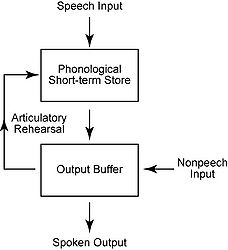音韻ループ
松吉 大輔
東京大学 先端科学技術研究センター
DOI:10.14931/bsd.2074 原稿受付日:2012年7月10日 原稿完成日:2012年7月17日
担当編集委員:定藤 規弘(自然科学研究機構 生理学研究所 大脳皮質機能研究系)
英語名:phonological loop 独:phonologische Schleife 仏:boucle phonologique
音韻ループ (おんいんるーぷ) とは、Baddeleyのワーキングメモリーモデルにおける中央実行系に隷属するサブシステムの1つであり、言語・音韻情報を保持する記憶貯蔵庫である[1]。言語の獲得に重要であると考えられている。
音韻ループの構造
音韻ループは、他のワーキングメモリー要素に比べ、最も研究が進んでいるとされる。
Baddeley (1986)[2] によれば、音韻ループは、音韻ループは音韻貯蔵庫 (phonological store) と、構音リハーサル (arituclatory rehearsal) という大きく2つのシステムから構成されている。入力信号は音韻貯蔵庫と出力バッファとの間で構音リハーサルを繰り返しながら記憶痕跡を強め、中央実行系の指令を受けて音声として出力される。このモデルによれば、聴覚呈示された音声入力は音韻貯蔵庫へと直接入力されるのに対し、視覚呈示された文字や語は貯蔵庫には直接入らず、視覚コードから聴覚コードへの変換後に構音リハーサルされることで音韻貯蔵庫へと入力されるのだという[3]。
ただし、音韻ループに関する研究のほぼ全ては言語や音声に関するものであり、非言語の聴覚刺激(環境音や音楽等)がどのように音韻ループで処理されるかについては、今後の研究が待たれる[4]。
心理学的証拠
Baddeley (2000)[5] は、音韻ループによって説明可能な現象として次の5つを挙げた。
音韻類似性効果
音韻が類似している文字や単語は、正確に思い出す事が難しいという現象。これは音韻として符号化されていることを意味する[6][7]。
語長効果
短い単語よりも長い単語の方が、再生が難しいという現象。多数の音節からなる語は、リハーサルや再生を行うのが難しい。これは、記憶痕跡に減退のための時間を与えることになる[8]。
構音抑制
単語記憶課題を行う際、1秒ごとに、たとえば「ザ」と発話し続けなければいけないように構音抑制 (articulatory suppression) を行うと、主たる単語記憶課題の成績は著しく落ちる。これは構音リハーサルを阻害することによって、音韻ループ内の記憶痕跡の形成が不十分になるためと考えられる[8]。
異符号間の情報転送
視覚的に呈示された文字・単語では、しばしば、視覚コードから聴覚コードへと変換し、声に出さずに暗唱する。構音抑制は、視覚呈示された項目では記憶成績低下を引き起こすが、聴覚呈示された項目では成績低下を生じさせない。これは、聴覚刺激は音韻貯蔵庫へ自動的に登録されるためである[9]。
神経心理学的証拠
音韻短期記憶に障碍を持つ患者は、音韻貯蔵庫にその障碍が存在する。統合運動障碍 (apraxia) を持つ失語症 (aphasia) 患者は、構音に必要な発話運動コードを形成する事ができないため、構音リハーサルに障碍を持つ[10]。発話に困難を伴う構音障害 (dysarthria) 患者は、リハーサルには問題が無い。これはリハーサルには、明白な音声を伴う必要がない事を示している[11]。
神経基盤
ヒトの脳画像研究では、音韻ループの構成要素である音韻貯蔵庫と構音リハーサルがそれぞれ左半球の異なる部位で担われている事が明らかにされている。Paulesu et al (1993) は、ポジトロン断層法(PET)を用い、左の下部頭頂葉(ブロードマン40野)は音韻貯蔵に関与する一方、左の下前頭回(ブローカ野、ブロードマン44野)は構音リハーサルに関わっている事を示した[12]。後のfMRI研究[13] や損傷患者研究[14] も概ねこの知見を支持している。
しかし、音韻貯蔵庫と構音リハーサルがそれぞれ単一の領域によって担われているとする知見は、必ずしも全ての研究で支持されているわけではない。音韻貯蔵庫は音声刺激からの直接入力を受けると仮定されているが、受動的な音声聴取のみでは下部頭頂葉は活性化せず、後部側頭葉の活性化を認めるなど[15]、音韻ループの下位要素は単一脳領域ではなく、複数の領域によって担われているとする知見も多い[16]。Buchsbaum & D'Esposito (2008) は、音韻ループの下位要素を単一領域に帰属させるような仕方ではなく、会話の知覚と生成に関与する会話処理の感覚運動系という観点から、音韻記憶という概念を整理すべきであると主張し、左の後部側頭平面 (planum temporale) が聴覚-運動のインタフェースとして働いているとした[17]。
関連項目
参考文献
- ↑ A D Baddeley, G J Hitch
Working memory
G A Bower (Eds) "The Psychology of Learning and Motivation: Advances in Research and Theory" Academic Press (New York):1974 - ↑ 2.0 2.1 A D Baddeley
Working Memory
Oxford University Press:1986 - ↑ 3.0 3.1
Baddeley, A. (2003).
Working memory: looking back and looking forward. Nature reviews. Neuroscience, 4(10), 829-39. [PubMed:14523382] [WorldCat] [DOI] - ↑ 4.0 4.1
Baddeley, A. (2012).
Working memory: theories, models, and controversies. Annual review of psychology, 63, 1-29. [PubMed:21961947] [WorldCat] [DOI] - ↑
Baddeley, A. (2000).
The episodic buffer: a new component of working memory? Trends in cognitive sciences, 4(11), 417-423. [PubMed:11058819] [WorldCat] - ↑
CONRAD, R., & HULL, A.J. (1964).
INFORMATION, ACOUSTIC CONFUSION AND MEMORY SPAN. British journal of psychology (London, England : 1953), 55, 429-32. [PubMed:14237884] [WorldCat] [DOI] - ↑ A D Baddeley
Short-term memory for word sequences as a function of acoustic, semantic and formal similarity
Quarterly Journal of Experimental Psychology, 18(4), 362-365:1966 - ↑ 8.0 8.1 A D Baddeley, N Thomson, M Buchanan
Word length and the structure of short-term memory
Journal of Verbal Learning Verbal Behavior, 14(6), 575-589:1975 - ↑ D J Murray
Articulation and acoustic confusability in short term memory
Journal of Experimental Psychology, 78(4), 679-684:1968 - ↑ G S Waters, E Rochon
The role of high-level speech planning in rehearsal: Evidence from patients with apraxia of speech
Journal of Memory and Language, 31(1), 54-73:1992 - ↑ A D Baddeley, B A Wilson
Phonological coding and short-term memory in patients without speech
Journal of Memory and Language, 24(4), 490-502:1992 - ↑
Paulesu, E., Frith, C.D., & Frackowiak, R.S. (1993).
The neural correlates of the verbal component of working memory. Nature, 362(6418), 342-5. [PubMed:8455719] [WorldCat] [DOI] - ↑
Henson, R.N., Burgess, N., & Frith, C.D. (2000).
Recoding, storage, rehearsal and grouping in verbal short-term memory: an fMRI study. Neuropsychologia, 38(4), 426-40. [PubMed:10683393] [WorldCat] [DOI] - ↑
Vallar, G., Di Betta, A.M., & Silveri, M.C. (1997).
The phonological short-term store-rehearsal system: patterns of impairment and neural correlates. Neuropsychologia, 35(6), 795-812. [PubMed:9204486] [WorldCat] [DOI] - ↑
Binder, J.R., Frost, J.A., Hammeke, T.A., Bellgowan, P.S., Springer, J.A., Kaufman, J.N., & Possing, E.T. (2000).
Human temporal lobe activation by speech and nonspeech sounds. Cerebral cortex (New York, N.Y. : 1991), 10(5), 512-28. [PubMed:10847601] [WorldCat] [DOI] - ↑
Becker, J.T., MacAndrew, D.K., & Fiez, J.A. (1999).
A comment on the functional localization of the phonological storage subsystem of working memory. Brain and cognition, 41(1), 27-38. [PubMed:10536084] [WorldCat] [DOI] - ↑
Buchsbaum, B.R., & D'Esposito, M. (2008).
The search for the phonological store: from loop to convolution. Journal of cognitive neuroscience, 20(5), 762-78. [PubMed:18201133] [WorldCat] [DOI]
